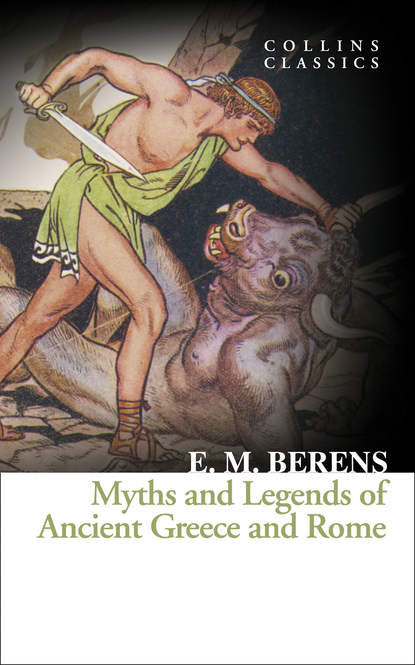По всем вопросам обращайтесь на: info@litportal.ru
(©) 2003-2024.
✖
Myths and Legends of Ancient Greece and Rome
Автор
Год написания книги
2019
Настройки чтения
Размер шрифта
Высота строк
Поля
Her favour was propitiated by offerings and sacrifices, principally consisting of black lambs. Her festivals were celebrated at night, by torchlight, when these animals were offered to her, accompanied by many peculiar ceremonies. These ceremonies were carried out with the minutest attention to details, as it was believed that the omission of the slightest particular would afford to her ministers, the evil spirits of the lower world, who hovered round the worshippers, an opportunity for entering among them, and exerting their baneful influence. At the end of every month food was placed wherever two roads met, in readiness for her and other malignant divinities.
In studying the peculiar characteristics which Hecate assumes when she usurps the place of Persephone, the rightful mistress of the lower world, we are reminded of the various superstitions with regard to spectres, witchcraft, &c., which have, even down to our own times, exerted so powerful an influence over the minds of the ignorant, and which would appear to owe their origin to a remote pagan source.
SELENE (LUNA). (#ulink_dde581f8-181a-57e1-a0f2-f87fbfc84a17)
Just as Helios personified the sun, so his sister Selene represented the moon, and was supposed to drive her chariot across the sky whilst her brother was reposing after the toils of the day.
When the shades of evening began to enfold the earth, the two milk-white steeds of Selene rose out of the mysterious depths of Oceanus. Seated in a silvery chariot, and accompanied by her daughter Herse, the goddess of the dew, appeared the mild and gentle queen of the night, with a crescent on her fair brow, a gauzy veil flowing behind, and a lighted torch in her hand.
Selene greatly admired a beautiful young shepherd named Endymion, to whom Zeus had accorded the privilege of eternal youth, combined with the faculty of sleeping whenever he desired, and as long as he wished. Seeing this lovely youth fast asleep on Mount Latmus, Selene was so struck with his beauty, that she came down every night from heaven to watch over and protect him.
ARTEMIS (DIANA). (#ulink_0b92b755-b368-5261-b8a1-2d19f25c1732)
Artemis was worshipped by the Greeks under various appellations, to each of which belonged special characteristics. Thus she is known as the Arcadian, Ephesian and Brauronian Artemis, and also as Selene-Artemis, and in order fully to comprehend the worship of this divinity, we must consider her under each aspect.
ARCADIAN ARTEMIS.
The Arcadian Artemis (the real Artemis of the Greeks) was the daughter of Zeus and Leto, and twin-sister of Apollo. She was the goddess of Hunting and Chastity, and having obtained from her father permission to lead a life of celibacy, she ever remained a maiden-divinity. Artemis is the feminine counterpart of her brother, the glorious god of Light, and, like him, though she deals out destruction and sudden death to men and animals, she is also able to alleviate suffering and cure diseases. Like Apollo also, she is skilled in the use of the bow, but in a far more eminent degree, for in the character of Artemis, who devoted herself to the chase with passionate ardour, this becomes an all-distinguishing feature. Armed with her bow and quiver, and attended by her train of huntresses, who were nymphs of the woods and springs, she roamed over the mountains in pursuit of her favourite exercise, destroying in her course the wild animals of the forest. When the chase was ended, Artemis and her maidens loved to assemble in a shady grove, or on the banks of a favourite stream, where they joined in the merry song, or graceful dance, and made the hills resound with their joyous shouts.
As the type of purity and chastity, Artemis was especially venerated by young maidens, who, before marrying, sacrificed their hair to her. She was also the patroness of those vowed to celibacy, and punished severely any infringement of their obligation.
The huntress-goddess is represented as being a head taller than her attendant nymphs, and always appears as a youthful and slender maiden. Her features are beautiful, but wanting in gentleness of expression; her hair is gathered negligently into a knot at the back of her well-shaped head; and her figure, though somewhat masculine, is most graceful in its attitude and proportions. The short robe she wears, leaves her limbs free for the exercise of the chase, her devotion to which is indicated by the quiver which is slung over her shoulder, and the bow which she bears in her hand.
Вы ознакомились с фрагментом книги.
Приобретайте полный текст книги у нашего партнера:
Приобретайте полный текст книги у нашего партнера:





